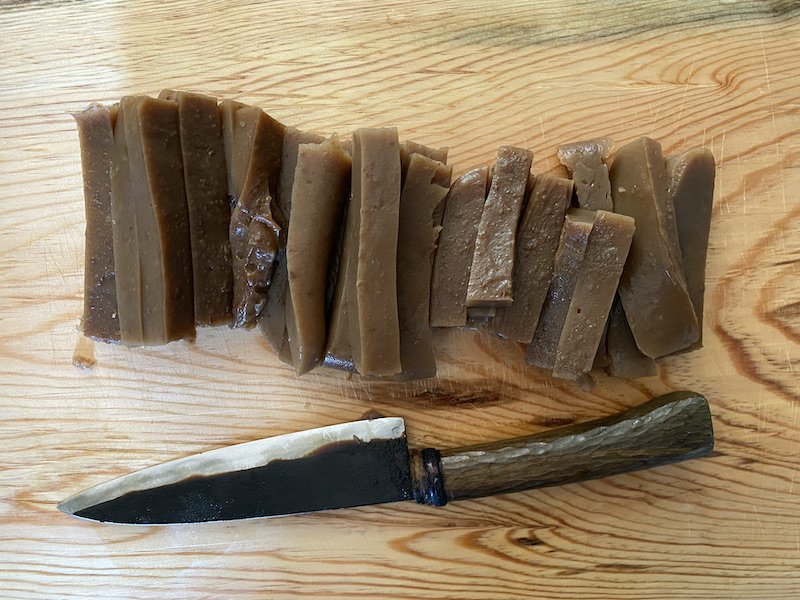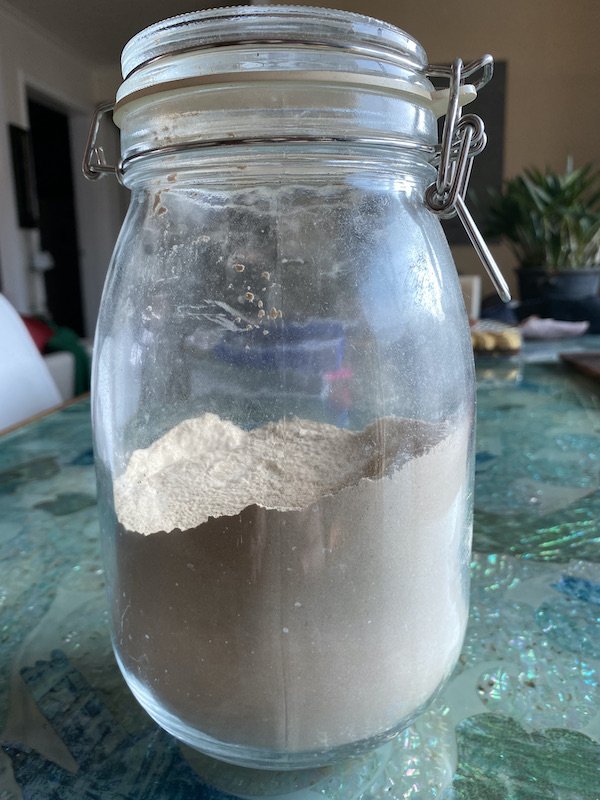Acorn for Dinner!
In a previous post I mentioned that here in Korea, eating acorns is still popular. They usually use powdered acorn to make a jelly called Dotori-muk. This weekend, my partner, Eungbok, made some Dotori-muk with flour she purchased from a chef colleague who gathers the acorns herself around where she lives in south Seoul.
In a previous post I mentioned that here in Korea, eating acorns is still popular. They usually use powdered acorn to make a jelly called Dotori-muk. This weekend, my partner, Eungbok, made some Dotori-muk with flour she purchased from a chef colleague who gathers the acorns herself around where she lives in south Seoul. Here’s what the flour looks like:
And here’s the jelly, which looks a bit like brown tofu:
Eungok mixed the flour with water, and with sesame oil to give it consistency. The flavour? I have to admit Dotori-muk doesn’t really have any. But the jelly-like texture is very pleasant. Anyway, Dotori-muk is usually served with a seasoning sauce or in a soup flavoured with radish and seaweed, which is how we ate it. It’s packed with goodness. Acorns are very nutritious and filling, while not containing fat, cholesterol, or sodium. Its health benefits include being an antioxidant, and it’s good for stomach ailments, helping in the promotion of healthy gut bacteria.
The species of oak that are preferred here to make flour are Quercus dentata and Quercus mongolica, whose acorns have less tannin than other oaks. The acorn of Quercus mongolica, aka the Mongolian oak, has a cup somewhat like those of the familiar European oaks but is more bumpy - more rugged, one could say. Quercus dentata, aka Korean oak, Japanese emperor oak, daimyo oak, or sweet oak, has a hugely hairy cup, so this one is very unlike those I’m familiar with from Europe. Like this:
Once upon a time, wherever there were oaks and human beings acorns were a stapple of the latter’s diet. As David A. Bainbridge writes in a fascinating essay entitled ‘Acorns as Food’ which I found on the Internet :
They occur in the archaeological record of the early town sites in the Zagros Mountains, at Catal Hüyük (6000 BC), and oak trees were carefully inventoried by the Assyrians during the reign of Sargon II. They have been used as food for thousands of years virtually everywhere oak trees are found. In Europe, Asia, North Africa, the Mid-East, and North America, acorns were once a staple food.
They were a staple food for people in many areas of the world until recently and are still a commercial food crop in several countries. The Ch'i Min Yao Shu, a Chinese agricultural text from the sixth century recommends Quercus mongolica as a nut tree. ……..
While it is often thought that oaks were a "wild crop" it is now clear that the oaks were planted, transplanted, and intensively managed. Informants and traditional songs tell of the selection and planting of oak trees. The early travelers often remarked on the “orchard like" settings encountered. How surprised they would be to find they were indeed orchards.
But as agriculture supplanted hunting-and-gathering, grains such as wheat, oats and rice became central to the human diet, and the acorn was relegated to being fodder for animals, such as swine. In medieval Europe in the autumn, swine would be released to forage for acorns in the forests, but their human owners would only recourse to the nut of the oak in times of want and famine. In other regions of the world, however, such as in what became California, Europeans arriving in the nineteenth century found that native American tribes treated acorns as a vital part of their diet. Of the situation today, Bainbridge writes:
A large commercial harvest still occurs in China, and acorns are sold on the streets by acorn vendors. The commercial harvest in Korea (where 1-2.5 million liters are harvested each year) provides prepared acorn starch and flour that reaches the American markets. Some acorns are collected in Japan. Acorns are still harvested and used in several areas of the United States, most notably Southern Arizona and California. There is still some harvesting in Mexico. Historically acorns were particularly important in California. For many of the native Californians, acorns made up half of the diet and the annual harvest probably exceeded the current sweet corn harvest in the state.
Why did the acorn get demoted in many places? It’s true that it takes time and effort to make an oak nut edible. An acorn is full of tannin, and so needs to be leached with water. But as Bainbridge writes:
Studies at Dong-guk University in Seoul, South Korea showed the tannin level in one species of bitter acorns was reduced from 9% to 0.18% by leaching, without losing essential amino acids. Virtually all of the acorns the native Californians used were bitter and they were leached or soaked in water to remove the bitterness. They apparently based their preference on oil content, storability, and flavor rather than sweetness.
Perhaps after the agricultural ‘revolution’, acorns, like all the other nuts that were once foraged by hunter-gatherers, were on an unconscious level too deeply associated with more ‘primitive’ stages of social development, and so had to be relegated, lest they remind humanity of the price they had paid for becoming sedentary and toilers of the soil. After all, Jared Diamond calls the agricultural revolution “the worst mistake in the history of the human race.” Hunter-gatherers had a more varied diet, including fats, proteins and vitamins…..and acorns. Farmers’ diet were simpler and less diverse, and they were constantly at risk of crop failure……when they would revert to the time-honoured convention of eating acorns. Add to this the fact that sedentism vastly increased the likelihood of contracting communicable diseases, and the agricultural revolution does start to seem less than magnificent evidence of humanity’s ability to perpetually develop towards greater general prosperity and well-being.
And now that the next ‘revolution’ - the industrial - is proving far from an unalloyed success, too, there are sound reasons for re-adopting the acorn as part of our diet. As Bainbridge writes:
There is a growing recognition that tree crops can play an important role in sustainable food production. Trees can be grown with less annual disturbance of the agricultural ecosystem and their deep roots allow the trees to reach nutrients and moisture in the deep soil. Acorns are an excellent example of a grain that grows on trees. We must begin to consider these traditional crops that fit temperate and semi-arid climates rather than trying to change the environment to fit crops that require extensive inputs of fertilizer and water.
I also noted in my previous post a great TED Talk by Marcie Mayer the founder of Oakmeal, who certainly concurs with Bainbridge’s view on the future of the acorn as food. Here’s a link to the company’s website: https://www.oakmeal.com/
References:
David A. Bainbridge, ‘Acorns as Food. History, use, recipes, and bibliography’, Sierra Nature Prints, 2001.
https://www.academia.edu/3829415/Acorns_as_Food_Text_and_Bibliography



